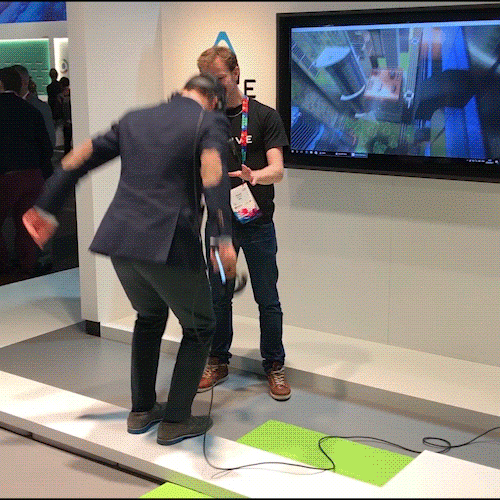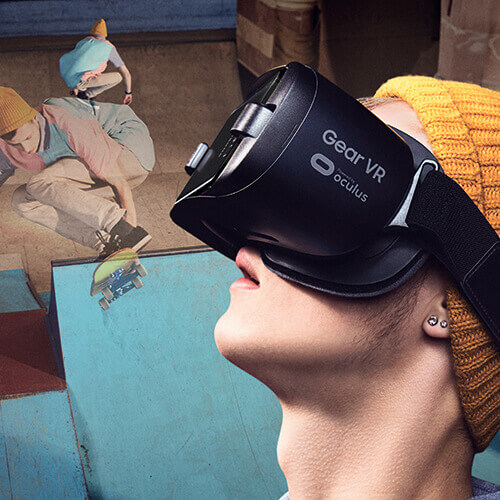What is VR and why should we care?
May 26, 2017

Next time you walk into a store and see an outfit – imagine being able to see if it fits in 4D by just snapping on a pair of VR glasses, without the need to queue endlessly for the changing room?
That’s just one of the nifty things that virtual reality is capable of. But what exactly IS virtual reality? And why should we be, to put it bluntly, bovvered?
The clue is in the name. It is the creation of a sense of reality using technology. So, by using images, sound and motion to generate 360-degrees of a designed environment, your brain can be tricked into thinking you’re in all kinds of crazy situations. Like outer space, or medieval France, or, of course, the changing room at H&M.
The Status Quo
At the launch of its critically lauded Vive headset, HTC invited the media to demo the tethered headset and controllers by transporting them to an underwater scene, more specifically, on the bow of a shipwreck, with a sting ray casually gliding past. It was realistic enough to actually make some people panic/freak out that they were still breathing.
As it is with any new technology, VR’s growth has been shaky, but it took just one man to bring virtual reality to the mass-consumer market, and into the media spotlight. Mark Zuckerberg turned up at the launch of Samsung’s then flagship, the Galaxy S7 and S7 edge to extol the virtues of virtual reality to an arena of journalists wearing Samsung’s Gear VR headsets. The photo of him walking past hundreds peering into the future has become iconic (albeit kinda creepy/terrifying.)
Samsung have continued their investment in virtual reality with an updated Gear VR headset. Timed to match the recent launch of the Samsung Galaxy S8, the equipment is lighter, more comfortable and cross-compatible with some of their newer accessories like the Samsung Gear 360 camera, allowing you to create your own content.
The History
Delve into virtual reality and you realise it is no spring chicken. While the term was coined in the early-’50s, it wasn’t until the ’60s that the phrase was patented. But, if we’re being technical, virtual reality can also be defined as a 360-degree photo, and as early as in the 1920s, flight simulators with wrap-around photos were being used!
It wasn’t until 1968 that the first head-mounted display (HMD) was created. Apparently, it was so heavy that Ivan Sutherland, the inventor, had to design a suspension system to support his head. Either that or his over-inflated smugness at creating something game-changing became a genuine health hazard.
In the 1970s, punters could take a leisurely walk through the town of Aspen in the United States courtesy of Massachusetts Institute of Technology (MIT) researchers.
Significantly, over the last couple of decades, this kind of technology has become more and more accessible, and affordable. You can pick up a phone and headset combo from the likes of Alcatel from £300, or use a Sony Playstation to get your VR kicks. The Google Cardboard version costs less than a fiver, but you’ll have to put in a bit of work to see results!
From Oculus to HTC Vive to Samsung Gear, virtual reality has certainly made inroads into all things mobile and consumer tech but there is more to it than meets the eye.

The Future
So, how can we see this technology impacting our lives? Here are just some of the cool things that manufacturers are pulling off…
The reality rollercoaster
A few weeks back, the world’s first VR-enhanced rollercoaster ride opened in Copenhagen. The ‘Demon’ is basically the cherry on the top of a multi-layered cake: a 77km/hr physical roller coaster ride with the VR headset heightening the adrenaline rush.
Medical marvels
Healthcare has embraced virtual reality with open arms. Surgery is the obvious one but rehabilitation of stroke and brain injury patients is an area where VR is making huge progress. The world of medicine can explore areas of the body, and effects of illness in more detail than ever before. Indeed, such is the inclusivity of VR (all you need is a functioning brain, some kind of head movement, and eyesight) that people who are limited in their movements or unable to experience life to the fullest can participate in virtual scenarios that would never be possible in real life.
A simulation nation
From training soldiers with simulations of conflict to showing museum-goers around ancient civilisations – the applications of the faux-environment are endless. Closer to home, imagine the power to walk around a property several times before renting it- without an estate agent trailing you? Or trying a holiday before you buy? You can even decide whether or not to go through that expensive side return renovation by getting to see your home post-makeover before any walls have come crashing down. Indeed, buying something online never has to feel like a gamble again. You can see how a sofa would look in your living room (thanks to augmented reality in stores and online), or whether your bridesmaid dresses go with the floral colour scheme, without relying on your imagination or memory.
Living the dream
Sony’s Playstation VR has been a serious hit and we expect to see many other gaming manufacturers jump into the fray. The level of interaction that VR affords means that game developers can design whole worlds for their audiences – to the point where people can experience the impossible. Take it one step further and we could be allowing people to exercise their wildest fantasies. Flying. Meeting ancestors. Curing phobias with immersion therapy. The question is – will VR start to become a preferable existence to our waking life if we’re all millionaires with total control of our own environments? Discuss.
A star-studded experience
If you thought Netflix was revolutionary, imagine how we’re going to consume content or experience life now that VR is a genuine option. Why get concert tickets at the back of the hall when you can enjoy a front-row performance from your own living room? No matter where you are in the world, you’ll have VIP experience of everything from films, to plays, to art exhibitions.
Is it worth the investment?
One crucial problem that mobile VR headsets suffer from is that they can only be as good as the phone they run off. And while the mobile phone being used might be the most powerful on the market, with screens capable of displaying more pixels per inch than discernible by the naked eye, we know there’s a long way to go before this technology reaches its potential.
However, progress is being made. Early this year in Vegas, Qualcomm, the chip manufacturer, showed off headsets capable of being untethered, without a mobile powering them. Elsewhere, HTC are apparently working on a smartphone capable of working with the fantastic Vive VR headset.
For virtual reality to truly find its niche, it has to be unshackled. Smartwatches have, by and large, remained slaves to mobile phones and this is why they have stayed as an accessory, rather than an essential.
Plus, for all its promise, virtual reality headsets come with their own set of issues. Researchers have talked about users becoming desensitised to situations because of excessive use of virtual reality gameplay. There are several concerns around health implications, too. The time lag or latency issues can mess with how your brain and neurons interact.
VR can be dangerous for children and most devices come with warnings that they are not to be used on those under-12. Nausea has been widely reported by purveyors of the systems and as with an excess of anything, it can be bad for the eyesight.
Sigh.
Yet, despite all the fuss, the worries seem rather puny in comparison to the worlds that virtual reality can unlock. Just exercise caution and off you go!